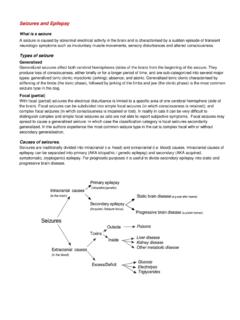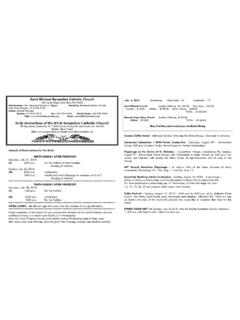Transcription of FELINE OROFACIAL PAIN (FOPS) Copyright © Clare …
1 FELINE OROFACIAL pain ( fops ) Copyright Clare rusbridge 2009 introduction FELINE OROFACIAL pain ( fops ) is a syndrome characterised by acute and severe oral and facial pain . Affected cats present with face and tongue mutilation and often have exaggerated licking and chewing movements especially after grooming or eating. The Burmese is predisposed. This syndrome of acute oral discomfort was first recognised in the early 1990s and is seen predominantly in Burmese cats. It is characterised by face and tongue mutilation and affected cats are most commonly presented with exaggerated licking and chewing movements, with pawing at the mouth. More severe cases have mutilation of tongue, lips and buccal mucosa.
2 Oral lesions and environmental stress can precipitate the condition. The disease is most likely a neuropathic pain disorder similar to trigeminal neuralgia. Pathogenesis It is hypothesised that this condition is caused by dysfunction of processing of sensory trigeminal information within the brain in combination with damage/sensitisation of the endings of the trigeminal nerves. The trigeminal nerve conveys sensory information, pain and touch, about the face and mouth to the brain. It has been suggested that affected cats have an underlying disorder processing sensory trigeminal information so that when trigeminal nerve endings are sensitised, by dental disease, the consequence is a neuropathic pain disorder.
3 Conditions of neuropathic pain can be greatly influenced by many internal and external factors, for example, individuals with poor social coping strategies may be more vulnerable. fops is thought to be similar to OROFACIAL pain disorders seen in humans for example trigeminal neuralgia. Trigeminal neuralgia is characterised by severe pain in the distribution of the trigeminal nerve, usually the mandibles and/or maxilla. The pain is precipitated by trigger factors, of which the most common is facial movement, ( chewing). A more unusual human facial pain syndrome, part of the spectrum of trigeminal neuralgia, is glossodynia (burning mouth syndrome). This is described as a burning or prickling sensation of the oral mucosa, most commonly at the front of the tongue.
4 In many of the affected cats, tongue discomfort seems to be the primary problem. Signalment The Burmese cat is over represented comprising 92% of cases in a recent study. However the disease has also been recorded in Siamese, Tonkinese, Burmilla, and the domestic shorthair. Any age of cat can be affected. However many affected cats will first show signs when erupting permanent teeth. There may be a slight bias towards males but a sex predisposition has yet to be been proved. Causes and risk factors Predilection to the Burmese cat (all colours) and their crosses suggests a hereditary susceptibility for some cases. Predisposing factors are oral lesions - in particular erupting permanent teeth, dental disease, (especially periodontal disease and dental resorptive lesions) and mouth ulceration.
5 The condition can also be triggered by routine dental treatment, including dental extraction. A recent study found that for 1 in 5 cases, environmental factors influenced fops and individuals with poor social coping strategies in multi-cat households appear to be more vulnerable to this condition. Clinical signs The main presenting signs are exaggerated licking and chewing movements, with pawing at the mouth. There may be self induced trauma to the face and oral cavity, especially the tongue. Neurological examination is normal; in particular there are no motor or sensory trigeminal deficits. Discomfort appears to be confined to the oral cavity and lips there is no apparent discomfort elsewhere in the distribution of the trigeminal nerve nose or eyes.
6 Typically the discomfort is unilateral or worse on one side. The cat remains alert and can be distracted, although with considerable difficulty in some cases. The cat may be anorexic / unwilling to eat. Clinical signs can be episodic or continuous. In episodic fops distress is often triggered by mouth movement eating or grooming. Episodes last between several minutes to several hours and are often preceded by a short period of behaviour suggesting anxiety. With continuous fops , affected cats appear to be in discomfort all the time and signs increases in intensity when excited, stressed or after mouth movement. These cases are at risk of severe oral cavity or face mutilation.
7 Diagnostic investigation There is no definite diagnostic test for this disease and the diagnosis is made on the basis of appropriate signalment, elimination of other explanations and identification of contributory causes. The main differential diagnoses are oropharyngeal foreign body and other neurological diseases causing dysfunction of processing of sensory trigeminal information within the nerve or brain. The most significant other cause of trigeminal lesions in the cat is neoplasia The affected cat should be investigated for predisposing medical problems, especially dental disease. Good quality dental radiographs are recommended and it is worth seeking a specialist opinion.
8 It is also recommended that serum biochemistry and haematology be performed to rule out other systemic disease. A neurological examination should be performed with particular emphasis on cranial nerve function. Routine neurological investigation, for example MRI and CSF analysis, are normal in cases of fops however they are useful to rule out other causes of trigeminal disease and are recommended in any cases with abnormal neurological examination especially abnormal facial sensation, movement and jaw tone. Further investigation is also recommended for cases with discomfort in a more unusual distribution eye or nose. As environmental factors can influence this condition it is important to explore the history for possible contributory factors social stress.
9 Identification of social incompatibility in a multi-cat household is a key step. Factors to consider are 1) does the cat have its own secure core territory ( own litter tray, feeding area and private space)? 2) visual access into the home, for example can the affected cat see another cat though a window? 3) points of entry and exit, for example, does another cat block access going in, out or even within a territory 4) Is there adequate provision of privacy? 5) Is the cat able use its natural behavioural strategies for coping with stress - such as hiding, elevation and distancing? Referral to a Specialist in behavioural medicine is worth considering. Treatment Until discomfort can be controlled mutilation should be prevented by using an Elizabethan collar and / or paw bandaging.
10 Soft Claws are an additional method of controlling self-mutilation. Any dental disease should be appropriately treated. It is worth considering referral to a veterinary dentist as inappropriate and overly traumatic dental surgery can aggravate this condition. FELINE Dental Resorption Lesions ( FELINE DR) are a considerable challenge to treat. Dental atomisation of retained roots should be avoided as the operator is unable to ensure avoiding collateral damage to surrounding bone. In addition, neurovascular bundles are present only 1-2mm beyond the root apices. This appears to be a condition of neuropathic pain and analgesia should be provided. Merely preventing the cat from mutilation without attempting to prevent the discomfort is inappropriate.








